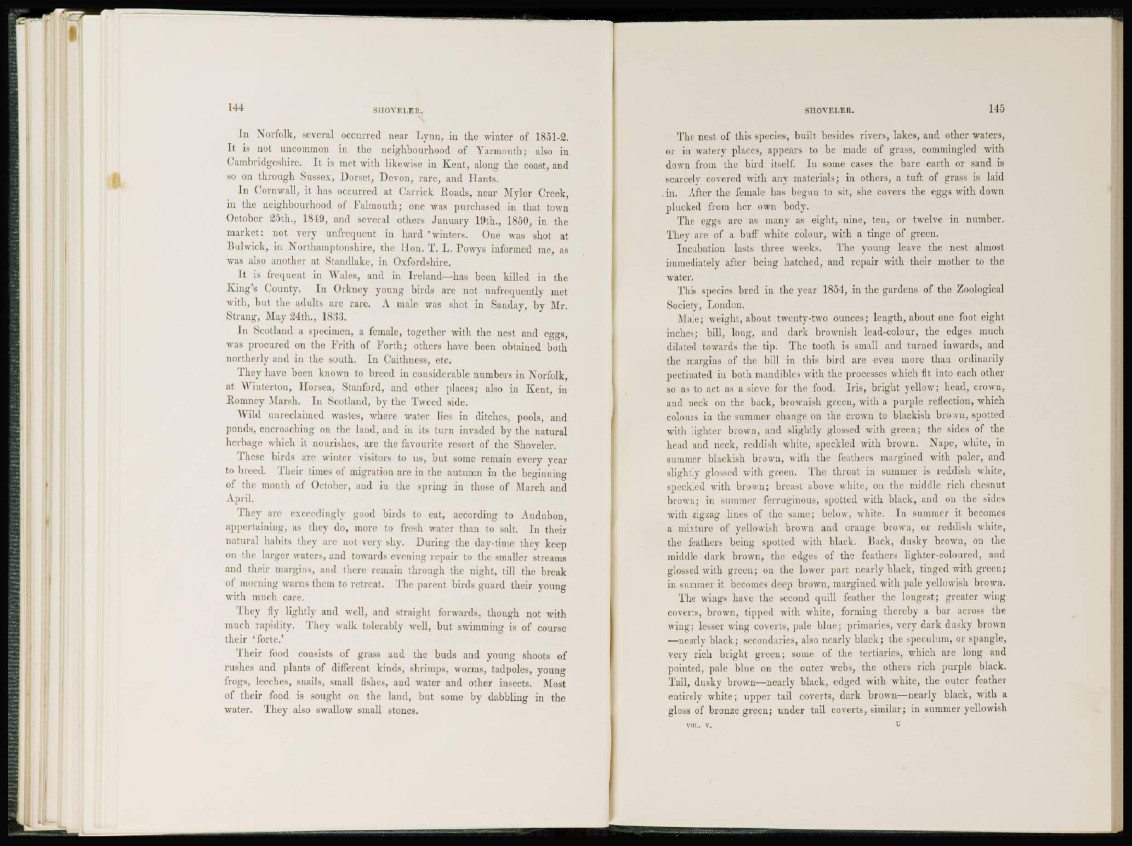
Iii Norfolk, several occurred near Lynn, in the winter of 1851-2.
I t is not uncommon in the neighbourhood of Yarmouth; also in
Cambridgeshire. It is met with likewise in Kent, along the coast, and
so on through Sussex, Dorset, Devon, rare, and 1 hints.
In Cornwall, it has occurred at Carrick Roads, near Mylor Creek,
in the neighbourhood of Falmouth; one was purchased in that town
October 85th., 1849, and several others January 19th., 1850, in the
market: not very unfrequent in hard " winters. One was shot at
Bulwick, in Northamptonshire, the Hon. T. L. Powya informed me, as
was also another at Standlake, in Oxfordshire.
I t is frequent in Wales, and in Ireland—has been killed in the
King's County. In Orkney young birds are not un frequently met
with, but the adults are rare. A male was shot in Sauday, by Mr.
Strang, May 24th., 1833.
In Scotland a specimen, a female, together with the nest and eggs,
was procured on the Frith of Forth; others have been obtained both
northerly and in the south. In Caithness, etc.
They have been known to breed in considerable numbers in Norfolk,
at Winterton, Horsea, Stanford, and other places; also in Kent, in
Romnev Marsh. In Scotland, by the Tweed side.
Wild unreclaimed wastes, where water lies in ditches, pools, and
ponds, encroaching on the land, and in its turn invaded by the natural
herbage which it nourishes, are the favourite resort of the Shoveler.
These birds are winter visitors to us, but some remain every year
to breed. Their times of migration are in the autumn in the beginning
of the month of October, and in the spring in those of March and
April.
They are exceedingly good birds to eat, according to Audubon,
appertaining, as they do, more to fresh water than to salt. In their
natural habits they are not very shy. During the day-time they keep
on the larger waters, and towards evening repair to the smaller streams
and their margins, and there remain through the night, till the break
of morning warns them to retreat. The parent birds guard their young
with much care.
They fly lightly and well, and straight forwards, though not with
much rapidity. They walk tolerably well, but swimming is of course
their 'forte.*
Their food consists of grass and the buds and young shoots of
rushes and plants of different kinds, shrimps, worms, tadpoles, young
frogs, leeches, snails, small fishes, and water and other insects. Most
of their food is sought on the land, but some by dabbling in the
water. They also swallow small stones.
SHOVELER. 115
The nest of this species, built besides rivers, lakes, and other waters,
or in watery places, appears to be made of grass, commingled with
down from the bird itself. In some cases the bare earth or sand is
scarcely covered with any materials; in others, a tuft of grass is laid
in. After the female has begun to sit, she covers the eggs with down
plucked from her own body.
The eggs are as many as eight, nine, ten, or twelve in number.
They arc of a buff white colour, with a tinge of green.
Incubation lasts three weeks. The young leave the nest almost
immediately after being hatched, aud repair with their mother to the
water.
This species bred in the year 1854, in the gardens of the Zoological
Society, London.
Male; weight, about twenty-two ounces; length, about one foot eight
inches; bill, long, and dark brownish lead-colour, the edges much
dilated towards the tip. The tooth is small and turned inwards, and
the margins of the bill in this bird are even more than ordinarily
pectinated in both mandibles with the processes which tit into each other
so as to act as a sieve for the food. Iris, bright yellow; head, crown,
and neck on the back, brownish green, with a purple reflection, which
colours in the summer change on the crown to blackish brown, spotted
with lighter brown, and slightly glossed with green; the sides of the
head and neck, reddish wdiite, speckled with brown. Nape, white, in
summer blackish brown, with the feathers margined with paler, and
slighily glossed with green. The throat in summer is reddish white,
speckled with brown; breast above white, on the middle rich chesnut
brown; in summer ferruginous, spotted with black, and on the sides
with zigzag lines of the same; below, white. In summer it becomes
a mixture of yellowish brown and orange brown, or reddish white,
the feathers being spotted with black. Back, dusky brown, on the
middle dark brown, the edges of the feathers lighter-coloured, and
glossed with green; on the lower part nearly black, tinged with green;
in summer it becomes deep brown, margined with pale yellowish brown.
The wings have the second quill feather the longest; greater wing
coverts, brown, tipped with wdiite, forming thereby a bar across the
wing; lesser wing coverts, pale blue; primaries, very dark dusky brown
—nearly black; secondaries, also nearly black; the speculum, or spangle,
very rich bright green; some of the tertiaries, which are long and
pointed, pale blue on the outer webs, the others rich purple black.
Tail, dusky brown—nearly black, edged with white, the outer feather
entirely white; upper tail coverts, dark brown—nearly black, with a
gloss of bronze green; under tail coverts, similar; in summer yellowish
VOL. v. u